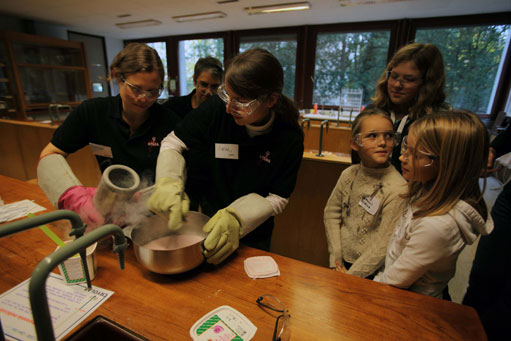
ATLAS e-News
23 February 2011
Getting girls on board with science
30 November 2009

Sarah Heim and Lorraine Courmeyea making liquid nitrogen ice cream
On November 14th, a crew of 12 ATLAS women laid down their physics tools and went back to school. Their mission: To show young girls how exciting and relevant science is.
Expand Your Horizons (EYH) is a day of hands-on workshops run by female scientists, for girls, to inspire them to pursue careers in the sciences, mathematics and engineering. The concept – to present girls with a winning combination of lively workshop sessions and inspirational female role models – began in the US in 1974. The Geneva conference was the first ever session in Europe, and attracted 270 girls and 60 adults. Alongside CERN were other organisations and companies, including Google, Ecole Polytechnique Fédérale de Lausanne, the World Health Organisation, Dupont, and the Swiss Space Foundation.
Conference Chairwoman, Jennifer Kealy, runs her own clinical research company in Geneva. For her, a key aim of the EYH movement is to catch girls in the 11-15 age group, while they still study subjects across the whole educational spectrum, and persuade them that scientific careers are an option for them. Targeting girls young, she says, is the only way to ensure that a higher proportion of female decision-makers begin to feed their way to the top.
“We’re setting policy for our children, and our children’s children. Energy, health, vaccinations, agriculture, education: all of those things are being decided by men,” she cautions. “There are no women at the table helping decide what direction we’re sending our world in.”
The Ecole Internationale de Genève was the setting for the day of fun, and the CERN team rocked up with laptops, liquid nitrogen, dry ice, ethanol and – importantly – marshmallows. The three CERN workshops ran concurrently at different locations on the campus, three times throughout the day. How does matter Matter sent the girls on a laptop Higgs hunt using the Minerva software developed at Lancaster University for Masterclasses; Supercool introduced them to the fun and physics of liquid nitrogen, and Seeing the Invisible had them building cloud chambers and then huddling round, hushed, ready to spot the ‘stardust’ trails of the mysterious cosmic rays whose existence they had just been told of.
“We don’t do this kind of stuff in class!” remarked one 12-year-old cloud chamber creator. Julia Gray was on hand to regale her and her friends with stories of how she had just been up all night on shift, watching the same cosmic rays shooting through the gigantic ATLAS detector. “The great thing about [the cloud chamber] is that it’s a detector that was really used in physics 70 or 80 years ago,” she told the girls.
Pauline Gagnon, one of the four leading the Supercool workshop came back with similar reports of the success of the hands-on nature of the session. “True, it's not difficult to captivate an audience with liquid nitrogen tricks but the girls were great: interested, captivated, eager to discover new things,” she says. One was so happy shrinking and expanding a balloon in a bowl of liquid nitrogen, that she kept doing it over and over again, saying, "In my physics class, we only got to watch this on video... This is really neat!"
Meanwhile, Monica Dunford was upstairs in the CERN booth at the careers fair, gesturing at the air around her and telling a pair of rapt ten-year olds, “The sky starts here!” while she explained Rayleigh scattering.
“This is way more interesting than what we do in school!” beamed one of the girls, who had previously been very concerned to find out where all the animals had been during the Big Bang.
“Kids always ask questions from an angle that you’re just totally not prepared for,” smiled Monica. “Whether one of them comes to work at CERN, or ten of them think ‘wow, that was cool’, it’s all good… Kids can go anywhere and do anything. It’s nice to be – in some small way – a part of that.”
Aside from all the fun, the serious aim of the conference was prominent in some of the volunteers’ minds. “I want girls to be excited about science. Look how many physicists there are at CERN – it’s disproportionate. [EYH is] better than nothing, but it’s just one day,” said ATLAS grad student Sarah Heim.
Although theoretically we live in times where academic opportunities for girls are equal to those of their male classmates, the lack of female role models might still be affecting girls on a subconscious level. According to Jennifer Kealy, the ATLAS volunteers at EYH were just the sort of dynamic, inspiring scientists that she wants young girls to see more of. “They engaged the girls and encouraged them to go forward with their studies,” she praised, adding: “Several girls who attended ATLAS workshops remarked that they will seriously consider physics in their future career plans.”

Ceri PerkinsATLAS e-News
|